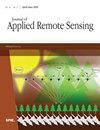M2-APNet:一个多模态深度学习网络,用于从时序卫星图像预测主要空气污染物
IF 1.4
4区 地球科学
Q4 ENVIRONMENTAL SCIENCES
引用次数: 0
摘要
空气质量监测对任何国家的可持续发展都起着至关重要的作用。持续监测主要空气污染物并预测其变化将有助于拯救环境和提高公共卫生质量。然而,由于地面仪器对空气污染物的观测空间有限,这一任务变得具有挑战性。我们提出了一个多模态深度学习网络(M2-APNet),从多模态时间卫星图像中预测全球范围内的主要空气污染物。M2-APNet的输入包括卫星图像、数字高程模型(DEM)和其他关键属性。本文提出的M2-APNet利用卷积神经网络提取局部特征,利用双向长短期记忆从多模态时间数据中提取纵向特征。这些特征融合在一起,揭示了有助于回归预测主要空气污染物和空气质量指数(AQI)分类的共同模式。我们进行了详尽的实验,通过采用多种时间模式来预测印度重要地区的空气污染物和AQI。此外,实验结果表明DEM模式在学习预测主要空气污染物和确定AQI方面的有效性优于其他模式。本文章由计算机程序翻译,如有差异,请以英文原文为准。
M2-APNet: A multimodal deep learning network to predict major air pollutants from temporal satellite images
Air quality monitoring plays a vital role in the sustainable development of any country. Continuous monitoring of the major air pollutants and forecasting their variations would be helpful in saving the environment and improving the quality of public health. However, this task becomes challenging with the available observations of air pollutants from the on-ground instruments with their limited spatial coverage. We propose a multimodal deep learning network (M2-APNet) to predict major air pollutants at a global scale from multimodal temporal satellite images. The inputs to the proposed M2-APNet include satellite image, digital elevation model (DEM), and other key attributes. The proposed M2-APNet employs a convolutional neural network to extract local features and a bidirectional long short-term memory to obtain longitudinal features from multimodal temporal data. These features are fused to uncover common patterns helpful for regression in predicting the major air pollutants and categorization of air quality index (AQI). We have conducted exhaustive experiments to predict air pollutants and AQI across important regions in India by employing multiple temporal modalities. Further, the experimental results demonstrate the effectiveness of DEM modality over others in learning to predict major air pollutants and determining the AQI.
求助全文
通过发布文献求助,成功后即可免费获取论文全文。
去求助
来源期刊

Journal of Applied Remote Sensing
环境科学-成像科学与照相技术
CiteScore
3.40
自引率
11.80%
发文量
194
审稿时长
3 months
期刊介绍:
The Journal of Applied Remote Sensing is a peer-reviewed journal that optimizes the communication of concepts, information, and progress among the remote sensing community.
 求助内容:
求助内容: 应助结果提醒方式:
应助结果提醒方式:


